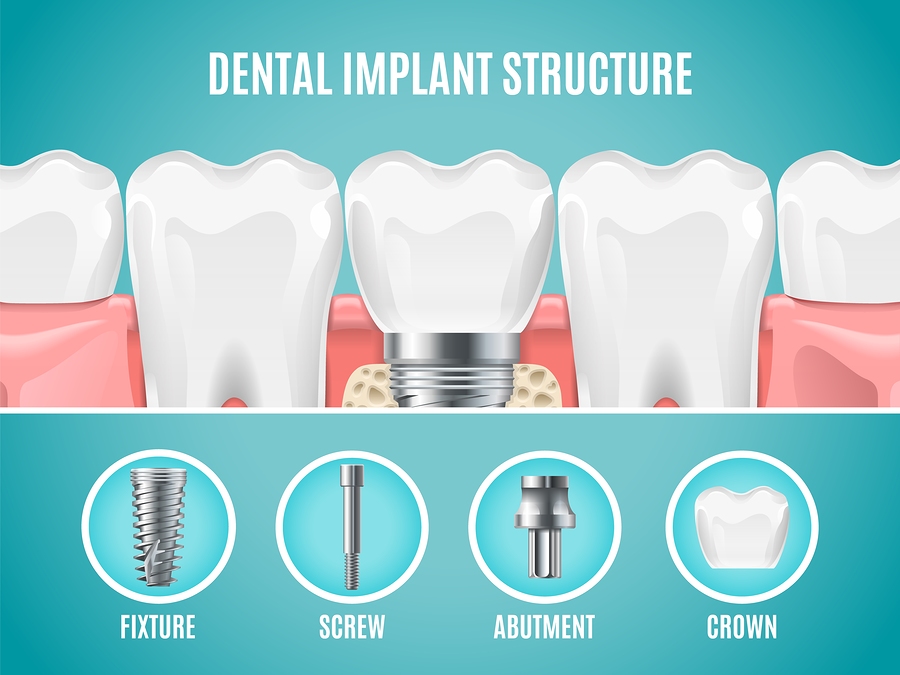Dental Sense Can Be Fun For Anyone
Dental Sense Can Be Fun For Anyone
Blog Article
Getting My Dental Sense To Work
Table of ContentsSome Known Questions About Dental Sense.Dental Sense - TruthsSome Of Dental SenseThe 6-Minute Rule for Dental Sense
are clinical gadgets surgically implanted right into the jaw to restore a person's ability to eat or their appearance. They provide support for fabricated (fake) teeth, such as crowns, bridges, or dentures. When a tooth is lost because of injury or illness, a person can experience issues such as fast bone loss, malfunctioning speech, or modifications to chewing patterns that cause discomfort.Dental dental implant systems contain a dental implant body and dental implant abutment and might also consist of a joint fixation screw. Wisdom tooth cavity. The dental implant body is surgically placed in the jawbone in place of the tooth's root. The dental implant joint is normally affixed to the dental implant body by the joint addiction screw and expands with periodontals right into the mouth to support the connected man-made teeth
(https://www.provenexpert.com/dental-sense/)Framework of The Dental Implant System choosing dental implants, speak with your dental supplier regarding the possible advantages and threats, and whether you are a candidate for the procedure. Points to consider: Your overall wellness is a crucial aspect in determining whether you are a great candidate for oral implants, for how long it will certainly take to recover, and how much time the dental implant might remain in location.
Smoking cigarettes may impact the recovery procedure and lower the long-lasting success of the dental implant. The recovery process for the implant body might take several months or longer, during which time you typically have a short-term abutment instead of the tooth. the dental implant treatment: Carefully adhere to the dental health instructions offered to you by your dental supplier.
Not known Details About Dental Sense
Implant failing can cause the need for an additional operation to deal with or replace the implant system. Recovers the capacity to eat Brings back cosmetic appearance Aids maintain the jawbone from reducing as a result of bone loss Protects the health and wellness of the surrounding bone and periodontals Aids keep nearby (close-by) teeth steady Enhances lifestyle Damage to bordering all-natural teeth throughout implant placement Injury to the surrounding cells during surgery, such as sinus opening Injury during surgical procedure (for instance, crack of bordering jawbone) Insufficient function, such as really feeling like the teeth do not bite together generally An experience that the tooth hangs or twisting in position resulting from an abutment screw loosening up Implant body failure (looseness of the dental implant body) because of systemic infection, which might be extra likely in people with unrestrained diabetes mellitus due to regional infection in bone and gums sustaining the dental implant body because of postponed recovery, which might be much more likely in patients who smoke Difficulty cleansing the gum tissues around the dental implant, causing poor oral health Without treatment periodontal condition Post-surgical numbness due to nerve impingement or damage Constantly inform wellness treatment carriers and imaging specialists that you have oral implants prior to any magnetic vibration imaging (MRI) or x-ray treatments.
FDA is not knowledgeable about any type of negative events reported for MRI or x-ray treatments with dental implants. Dental implants systems are usually constructed from materials that follow worldwide agreement standards of the International Organization for Standardization (ISO) or ASTM International. These standards have information of what makes a safe Front tooth filling material.

An oral implant is a framework that replaces a missing out on tooth. With screw-like gadgets, the surgeon inserts a dental implant right into the jawbone, and it functions as a support for a synthetic tooth, called a crown. A device called a joint links the synthetic tooth to the dental implant. The crown is custom-made to fit the individual's mouth and match the color of their teeth.
Dental Sense Fundamentals Explained
Some people are not eligible for dental implant surgical treatment. It is for dental surgeons to operate on individuals with: intense illnessuncontrollable metabolic diseasebone or soft cells disease or infectionIf these concerns are fixed, an individual can have the surgical treatment. In, oral doctors avoid from operating individuals with: If people with any one of the above undergo oral implant surgical treatment, there is a higher risk of the dental implant failing.

Dental implant surgical procedure is a personalized procedure. It's not the very same for everybody. Yet the adhering to gives a general overview of what you can expect your dentist, oral surgeon, periodontist or prosthodontist to do: Put the dental implant operatively. Give you time to recover. Affix the article and last crown, bridge or denture.
Next, your surgeon will meticulously put the oral implant into your jaw. If your dental implant is near the front of your mouth, your dental professional will make a short-lived tooth for you to use until you heal.
The smart Trick of Dental Sense That Nobody is Talking About
Your provider can inform you what to anticipate in your scenario. Throughout the recovery stage, your jawbone must fuse to the dental implant. This procedure, called osseointegration, is essential for stability and long-lasting success. This process can take anywhere from 3 to 9 months. In some instances, it may take longer.
As soon as your dental implant heals, your dental expert can attach the joint (tiny port message) and your final remediation (crown, bridge or denture). This typically takes regarding one hour to complete and may need a 2nd minor surgical treatment. You shouldn't feel any type of discomfort throughout your oral implant procedure since your provider will utilize medicine to numb your gum tissues.
Report this page